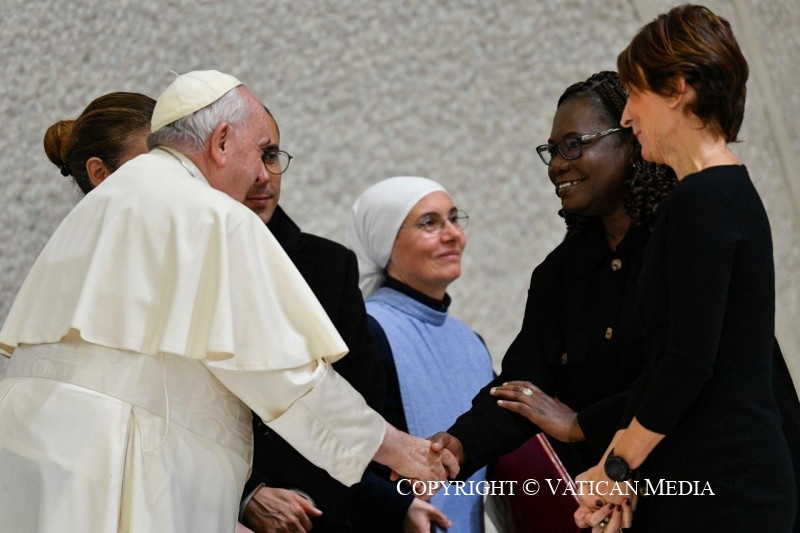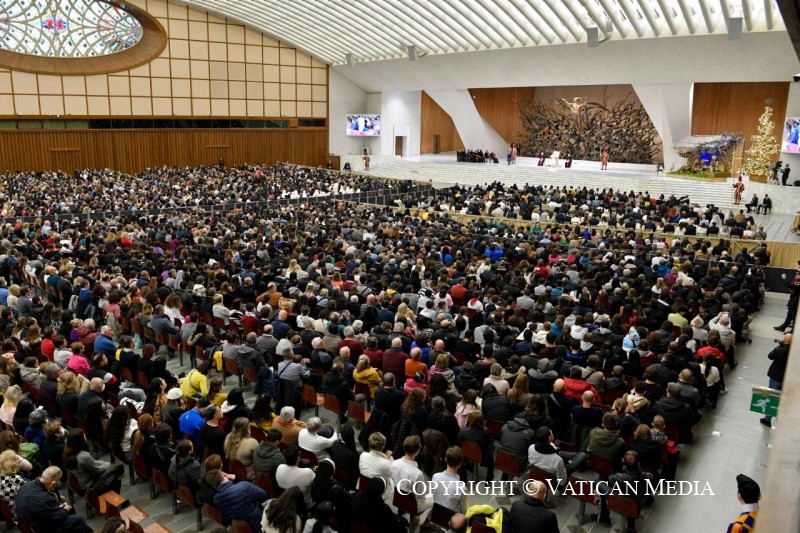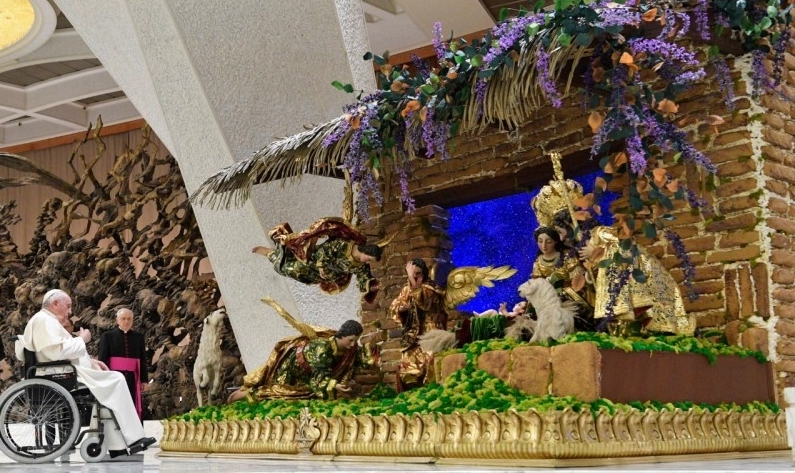(ZENIT News / Vatican City, 28.12.2022).- On Wednesday morning, December 28, Pope Francis held his General Audience in Paul VI Hall in the Vatican. The catechesis on discernment, a subject to which he has dedicated 13 catecheses, was interrupted by a catechesis on Christmas, making use of texts of Saint Francis de Sales. The inclusion of this topic was due to the fact that December 28 marked the 400th anniversary of the death of the Saint and Doctor of the Church.
Here is the text of the catechesis, translated from the Italian original by the Holy See.
* * *
The liturgical season invites us to pause and reflect on the mystery of Christmas. And since today marks the fourth centenary of the death of St Francis de Sales, Bishop and Doctor of the Church, we can take a cue from some of his thoughts. He wrote a great deal about Christmas. In this regard, I am pleased to announce that the Apostolic Letter commemorating this anniversary is being published today. The title is “Everything Pertains to Love,” taking up a characteristic expression of Saint Francis de Sales. In fact, this is what he wrote in his Treatise on the Love of God: “In Holy Church, everything pertains to love, lives in love, is done for love and comes from love” (Italian original from: Ed. Paoline, Milan 1989, p. 80). And may we all go down this path of love, which is so beautiful.

Let us then try to delve a little deeper into the mystery of Jesus’ birth, “in the company” of St Francis de Sales, thus uniting the two commemorations.
Saint Francis de Sales, in one of his many letters addressed to Saint Jeanne Frances de Chantal, writes as follows: “I imagine I see Solomon on his ivory throne, all beautifully gilded and carved, which, as the Scripture tells us, had no equal in all the kingdoms of the earth (1 Kings 10:18-20) neither was there any king that could be compared, for glory and magnificence, with the king that sat upon it (1 Kings 10:23). And yet, I would a hundred times rather see the dear Jesus in his Crib, than all the kings of the world on their thrones” [1]. What he says is beautiful.
Jesus, the King of the universe, never sat on a throne, never: He was born in a stable — we see it represented thus [indicating the manger scene in the Paul VI Hall] — wrapped in swaddling clothes and laid in a manger; and finally He died on a cross and, wrapped in a sheet, was laid in the tomb. Indeed, the evangelist Luke, in recounting the birth of Jesus, insists a great deal on the detail of the manger. This means that it is very important not only as a logistical detail. But how to understand it as a symbolic element? In order to understand what kind of Messiah is He who was born in Bethlehem; what kind of King He is, Who Jesus is.

Seeing the manger, gazing upon the cross, looking at His life, a life of simplicity, we can understand who Jesus is. Jesus is the Son of God Who saves us by becoming man, like us; stripping Himself of His glory and humbling Himself (cf. Philippians 2:7-8). We see this mystery concretely in the focal point of the crib, namely in the Child lying in a manger. This is “the sign” that God gives us at Christmas: it was at the time for the shepherds in Bethlehem (cf. Luke 2:12), it is today, and it will always be so. When the Angels announce the birth of Jesus, [they say,] “Go and you will find Him”; and the sign is: You will find a child in a manger. That is the sign. The throne of Jesus is the manger or the street, during His life, preaching; or the Cross at the end of His life. This is the throne of our King.
This sign shows us the “style” of God. And what is the style of God? Don’t forget, never forget: the style of God is closeness, compassion, and tenderness. Our God is close, compassionate, and tender. This style of God is seen in Jesus. With this style of His, God draws us to Himself. He does not take us by force, He does not impose His truth and justice on us. He does not proselytize us, no! He wants to draw us with love, with tenderness, with compassion.
In another letter, St Francis de Sales writes: “The magnet attracts iron, amber attracts straws. Whether, then, we are iron in our hardness, or straws in our lightness and worthlessness, we must unite ourselves to this little Infant” [2]. Our strengths, our weaknesses, only resolve themselves before the crib, before Jesus, or before the Cross. Jesus stripped, Jesus poor; but always with His style of closeness, compassion, and tenderness. God has found the means to attract us however we are: with love. Not a possessive and selfish love, as unfortunately human love so often is. His love is pure gift, pure grace, it is all and only for us, for our good. And so He draws us in, with this unarmed and even disarming love. Because when we see this simplicity of Jesus, we too cast aside the weapons of pride and go, humbly, to ask for salvation, to ask for forgiveness, to ask for light for our lives, in order to be able to move forward. Do not forget the throne of Jesus. The manger and the Cross: this is the throne of Jesus.

Another aspect that stands out in the crib is poverty — truly, there is poverty there — understood as the renunciation of all worldly vanity. When we see the money that is spent on vanity . . . so much money [spent] on worldly vanity; so much effort, so much seeking after vanity; when Jesus makes us see with humility.
St Francis de Sales writes: “My God! my daughter, how many holy affections does this birth make rise within our hearts, above all of the perfect renunciation of the goods, the pomp, [. . . ] of this world. I do not know whether I find any mystery which so sweetly mingles tenderness with austereness, love with rigour, sweetness with severity” [3]: we see all this in the Nativity scene. Yes, let us be careful not to slip into the worldly caricature of Christmas. And this is a problem, because this is Christmas. But today we see that, even if there is “another Christmas,” in quotation marks, it is the worldly caricature of Christmas, that reduces Christmas to a sappy, consumerist celebration. We want to celebrate, we want to, but this is not Christmas, Christmas is something else. God’s love is not sugar sweet; Jesus’ manger shows us that. It is not a hypocritical goodness that hides the pursuit of pleasures and comforts. Our elders, who knew war and also hunger, knew this well: Christmas is joy and celebration, certainly, but in simplicity and austerity.
And let us conclude with a thought of St Francis de Sales that I have also taken up in the Apostolic Letter. He dictated it to the Visitandine Sisters — just think! — two days before his death. And he said: “Do you see the Baby Jesus in the crib? He accepts all the discomforts of that season, the bitter cold and everything that the Father lets happen to Him. He does not refuse the small consolations that his Mother gives him; we are not told that He ever reached out for his Mother’s breast, but left everything to her care and concern. So too, we ourselves should neither desire nor refuse anything, but accept all that God sends us, the bitter cold and the discomforts of the season,” everything. [4].

And here, dear brothers and sisters, is a great teaching, which comes to us from the Child Jesus through the wisdom of St Francis de Sales: to desire nothing and reject nothing, to accept everything that God sends us. But be careful! Always and only out of love, always and only out of love, because God loves us and only ever wants our good.
Let us look to the manger, which is the throne of Jesus; let us gaze upon Jesus in the streets of Judea, of Galilee, preaching the message of the Father; and let us look upon Jesus on the other throne, on the Cross. This is what Jesus offers us: the street, but this is the path of happiness.
To all of you and your families, a happy Christmas season and a happy New Year!
Notes:
[1] To Chantal’s Mother, Annecy, December 25 , 1613, in Tutte le Lettere, Vol. II, p. 1. II (1619-1622). Edited by L. Rolfo, Paoline, Rome, 1967, 402-403 (Oeuvres de Saint François de Sales, Complete Edition, Annecy, Tome XVI, 120-121).
[2] To a Religious, Paris, around June 6, 1619, in Tutte le Lettere, Vol. I, p.1. III (1619-1622), edited by L. Rolfo, Paoline, Rome, 1967, 10 (Oeuvres de Saint François de Sales, Complete Edition, Annecy, Tome XVIII, 334-335).
[3] To a Religious of the Abbey of Saint Catherine, Annecy, 25 or 26 December, 1621, in Tutte le Lettere, Vol. I, p. 1. III (1619-1622), edited by L. Rolfo, Paoline, Rome, 1967, 615 (Oeuvres de Saint François de Sales, Complete Edition, Annecy, Tome XX, 212).
[4] Trattenimenti Spirituali, Paoline, Milan, 2000, 463 (F. de Sales, Spiritual Talks, Oeuvres. Texts presented and annotated by A. Ravier with the collaboration of R. Devos, Bibliothèque de la Pléiade, Gallimard, Paris, 1969, 1319).



